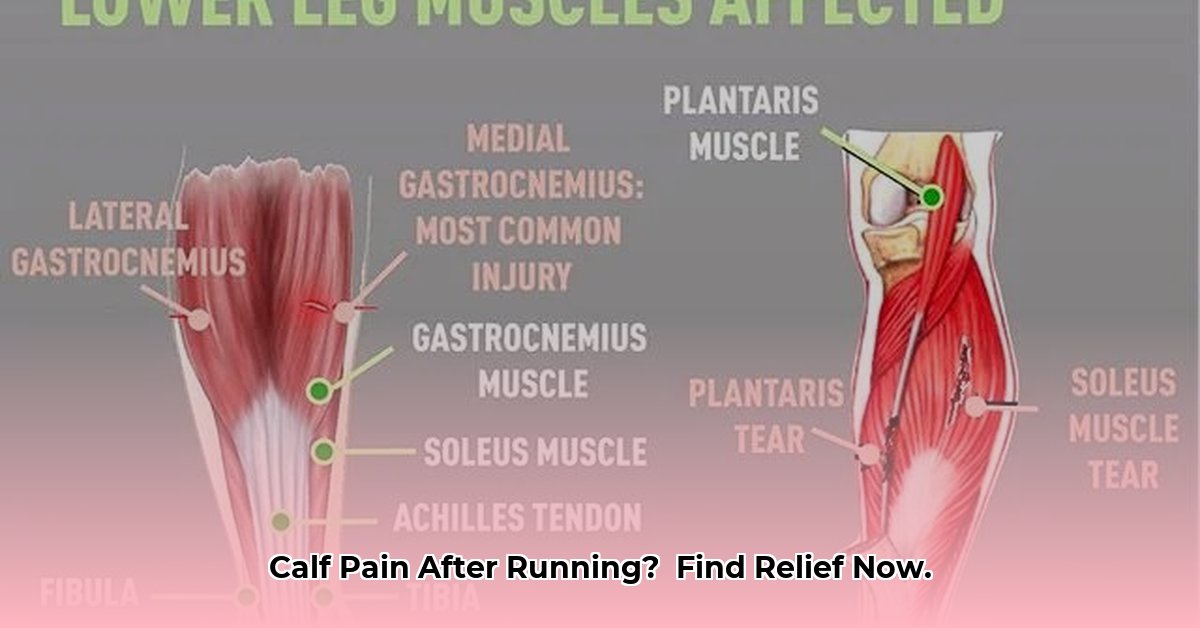Understanding Your Calf Pain
Running can bring joy and fitness, but calf pain can sideline even the most dedicated runner. This guide decodes calf pain, offering insights into causes, treatment, and prevention. Whether a sharp jab or a dull ache, understanding your pain is the first step to recovery.
The Calf Muscle Complex: Your Running Engine
Your calves, located on the back of your lower leg, propel you forward with every stride. The gastrocnemius (the prominent, two-headed muscle) and the soleus (a smaller, deeper muscle), connected to your heel by the Achilles tendon, are essential for running. Understanding their function is key to understanding their pain.
Common Causes of Calf Pain in Runners
Several factors contribute to calf pain:
- Overtraining: Increasing mileage or intensity too quickly overloads calf muscles.
- Beginner Status: Under-conditioned calf muscles in new runners, especially those with a midfoot strike, are prone to pain.
- Hill Running: The increased incline demands more from your calves.
- Running Surface: Soft or uneven terrain increases ankle range of motion, potentially straining calf muscles.
- Running Speed: Higher speeds mean greater impact and muscle exertion.
- Overstriding: Long strides overstretch and strain calf muscles.
- Improper Footwear: Worn-out or ill-fitting shoes lack support, stressing your calves.
- Dehydration & Electrolyte Imbalance: Muscle cramps, mimicking or exacerbating calf pain, can result from these imbalances.
- Muscle Strains: Tears in muscle fibers cause significant pain.
- Referred Pain: Issues like Achilles tendinopathy or plantar fasciitis can cause referred pain in the calf.
| Cause | Description |
|---|---|
| Overtraining | Increasing mileage or intensity too rapidly before your body is ready. |
| Beginner Runner | Calf muscles are often under-conditioned in new runners, particularly with a midfoot strike. |
| Hill Running | Running uphill increases the demand on calf muscles. |
| Running Surface | Soft or uneven surfaces, like trails or sand, can add strain due to increased ankle range of motion. Paved surfaces can also contribute to repetitive stress injuries. |
| Running Speed | Faster paces increase impact and muscle exertion. |
| Overstriding | Excessively long strides overstretch and strain calf muscles, particularly during the eccentric (lengthening) phase. |
| Improper Footwear | Worn-out or poorly fitting shoes lack support, overworking calf muscles and potentially leading to other injuries. |
| Muscle Strains | Tears in muscle fibers, ranging from minor to severe, often caused by sudden movements or overuse. Grades 1-3 denote severity, with 3 being the most severe, potentially a complete tear. |
| Dehydration/Electrolyte Imbalance | Muscle cramps often result from dehydration and electrolyte imbalances. |
| Referred Pain | Pain originating from other areas, such as the Achilles tendon (Achilles tendinopathy), plantar fascia (plantar fasciitis) or even the lower back, radiating to the calf. |
| Muscle imbalances | Weakness in surrounding muscles, particularly the tibialis anterior (shin muscle) may overload the calf during activity |
Recognizing Calf Pain Symptoms
Differentiating typical post-run soreness from something more serious is crucial. Consider the following:
- Pain Type: Is it sharp, stabbing, dull, aching, tight, or cramping?
- Location: Is the pain generalized or localized to a specific area?
- Other Symptoms: Swelling, tenderness, redness, warmth, tingling, or numbness suggest a potentially more serious issue. Radiating pain also warrants investigation.
- Onset: Did the pain come on suddenly or gradually?
- Duration: Is the pain constant or intermittent? How long has it lasted?
- Aggravating/Relieving Factors: What makes the pain better or worse?
| Type of Pain | Potential Causes | Symptoms |
|---|---|---|
| Sharp, Stabbing | Muscle strain, tear | Sudden onset, localized pain, difficulty moving the ankle, possible bruising |
| Dull, Achy | DOMS, overuse, muscle imbalances | Generalized soreness, stiffness, especially after rest |
| Tightness, Cramping | Muscle fatigue, dehydration, electrolyte imbalances | Feeling of restriction, muscle spasms, or cramping |
| Chronic, Persistent | Achilles tendinopathy, compartment syndrome, stress fracture, nerve compression | Ongoing discomfort, worsening with activity, possible swelling, numbness, or weakness in the foot/ankle |
Treatment: Soothing Your Calves
If your calves are aching, start with RICE:
- Rest: Avoid aggravating activities.
- Ice: Apply ice packs for 15-20 minutes every few hours.
- Compression: Use a compression bandage.
- Elevation: Raise your leg above your heart.
Over-the-counter pain relievers like ibuprofen or naproxen can help, but persistent or severe pain requires professional medical advice.
Preventing Calf Pain
Preventing calf pain is often easier than treating it:
- Gradual Progression: Gradually increase mileage and intensity.
- Warm-up: Prepare your muscles before running with dynamic stretches.
- Cool-down: Include static stretches post-run.
- Hydration & Nutrition: Fuel your muscles properly.
- Rest & Recovery: Allow muscles time to repair.
- Proper Footwear: Wear supportive, well-fitting shoes.
- Strength Training: Strengthen calf muscles with exercises like calf raises and toe raises. Start with isometric calf raises against a wall and gradually increase the intensity as you improve. Consider adding eccentric exercises (slowly lowering the heel from a raised position) and plyometrics for experienced runners, but only after any current injury has healed.
- Running Form: Aim for shorter, quicker strides.
- Cross-Training: Incorporate low-impact activities like swimming or cycling to maintain fitness while reducing stress on calves.
- Regular Stretching and Foam Rolling: Maintain muscle flexibility and prevent tightness. Stretching can improve blood flow and reduce the risk of injury. Pay attention to form and stop stretching immediately if you feel any pain.
- Listen to Your Body: Pay attention to early warning signs of pain and adjust your training accordingly.
- Address Biomechanical Issues: Consider consulting a physical therapist or podiatrist to identify and address any biomechanical issues, such as overpronation, that may contribute to calf pain. Sometimes, custom orthotics may be recommended to provide additional support.
Advanced Considerations and Troubleshooting
- Hip Weakness: Weak hips destabilize your running form, increasing stress on your calves. Incorporate hip-strengthening exercises into your routine.
- Nutrition & Hydration: Proper nutrition and hydration are essential for muscle function and recovery. Electrolyte imbalances can contribute to muscle cramps.
- Chronic Pain: Persistent calf pain may require professional guidance from a sports medicine specialist. Consider exploring other potential factors, like muscle imbalances or nerve compression.
- Troubleshooting: If pain persists, consider factors like your running form, running surface, and footwear. Consider consulting with a physical therapist, podiatrist, or sports medicine doctor for personalized evaluation.
When to Seek Professional Help
Consult a doctor or physical therapist if you experience:
- Severe pain
- Significant swelling, redness, or warmth
- Numbness or tingling
- Pain that doesn’t improve with rest and RICE
- Inability to bear weight
Conclusion
By understanding the causes, symptoms, treatment, and prevention of calf pain, you can keep running strong. Remember, this information is for general knowledge and doesn’t replace professional medical advice. Always consult a healthcare professional for personalized guidance. Ongoing research continues to shed light on calf pain, so staying informed is essential. Take care of your calves, and they’ll keep you moving forward.
- Bento Box Shopping Tips for Smart and Stylish Lunch Prep - December 14, 2025
- Bento Box Trays Streamline Restaurant Meal Presentation and Transport - December 13, 2025
- Plastic Bento Boxes Face Scrutiny Over Sustainability Impacts - December 11, 2025










